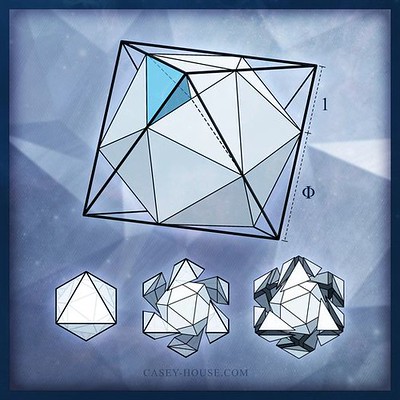RBF, Synergetics, Fig. 988.00 Polyhedral Evolution:
S Quanta Module:
Comparisons of skew polyhedra
I get flak sometimes for being such a Platonist, meaning what exactly? I'm OK with contemplating pure patterns of no obvious significance in terms of paying bills or putting food on the table. I'm simply pleased they exist. This is one way I pursue (and sometimes attain) a level of happiness.
For example, I'm assured by reasonable math-oriented folks that it's perfectly meaningless that the following ratios hold true:
- S Factor: S : E :: CO(D) : Icosa(D)
- S3: SuperRT : CO(D) :: Cube(R) : Tetra(D)
First: what does it all mean? and second: who cares?
S and E are two of the Synergetics BEAST modules, irregular tetrahedrons defined in terms of the concentric hierarchy (CH).
The CH is the geometric centerpiece of Synergetics, R. Buckminster Fuller's transcendentalist geometry (i.e. philosophy).
The S modules, 12 left and 12 right handed, brick in the difference twixt an Icosahedron of edges S Factor (about 1.08), and its faces-flush nest, an Octahedron of edges D (2R) and volume 4.
Here's a poster showing an S mod from Syn-U by Casey House:
The phi cut is along an edge of 2R (D). The IcosaWithin -- as David Koski and I call it -- with eight faces flush to those of the Octahedron, has edges S Factor, and a volume of about 2.92.
All volumes are in tetravolumes i.e. the volume of the D-edged tetrahedron is our unit.
D is for diameter, R is for radius (1/2 the diameter). Icosa(D) is an icosahedron with edges D or 2R. Its volume is about 18.51.
Cube(R)/Tetra(D) is known as S3, or "Synergetics Constant", and it relates the respective unit volumes within the XYZ and IVM contexts (namespaces) respectively. In the XYZ context, we take the R-edged cube for a unit, whereas in the IVM context, a corresponding unit of volume is a D-edged tetrahedron, a little less. S3 is about 1.06066.
The SuperRT is a Rhombic Triacontahedron, a triac, with long face diagonals equal to the edges of Icosa(D). Its short diagonals form a pentagonal dodecahedron (PD). The two combined give the SuperRT, which is phi-up from the RT of 120 E modules. S:E is our S Factor.
The SuperRT : CO(D) ratio is the same as the Cube(R) : Tetra(D) ratio.
Who cares? Those of us wanting to get our heads around the Concentric Hierarchy, the centerpiece of (backbone of) Synergetics.
See: Polyhedron Play section of this Jupyter Notebook Polyhedrons Я Objects



